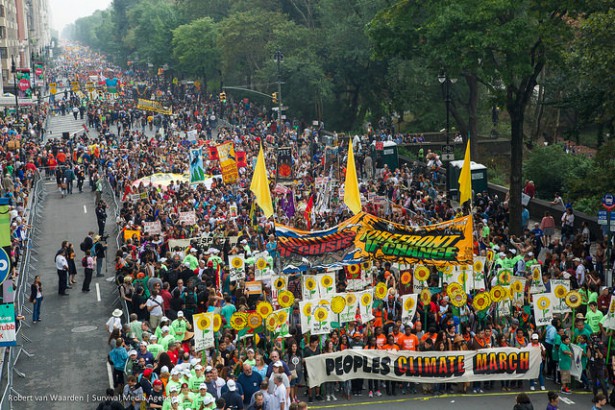 More than 400,000 people took part in the People’s Climate March last month in New York City. (Survival Media Agency / Robert van Waarden)
More than 400,000 people took part in the People’s Climate March last month in New York City. (Survival Media Agency / Robert van Waarden)
When NOT to march (or rally)
by Andrew Willis Garces
On an ordinary Tuesday evening in April 2007, dozens of union janitors gathered outside a downtown office building in Sydney, Australia, to celebrate a victory: After a long fight, another cleaning contractor had agreed to sign up with the janitors’ union. Singing “Don’t Stop the Cleaners” to the tune of “Don’t Stop Believin’” and pounding drums and shaking noisemakers, the assembled janitors listened to union leaders talk about their next target: the cleaning contractor of that very office building in front of them, which was still nonunion. After sending this message, cheering and chanting, the group marched back to the union office for a celebratory barbecue.
As this example shows, marches and rallies can be a great way to celebrate a big campaign victory (and gear up for the next one). They’re accessible, often relatively simple to plan, and can easily incorporate participation from many kinds of people. Good marches and rallies have a few functions. They can be a good place to announce you’ve reached a new stage, or otherwise serve as a movement’s marking point, such as the 1963 March on Washington. They can inspire your grassroots base with new energy. Or, ideally, they can move you past the finish line and into your campaign victory lap.
But too often we use marches and rallies in place of any other public action to put pressure on decision-makers and build support for our campaign. They’re good for partying or as a mass mobilization after grassroots support is built — but there are many more effective ways to create low-risk opportunities for gathering people together. On the heels of the People’s Climate March last weekend, where more than 300,000 people gathered to demand international action on climate change, it’s important to take the time to reflect on what marches can accomplish — and what other tactics can be used instead.
Continue to read about alternatives to marching and rallying and when this tactic is best initiated in this article by Andrew Willis Garcés.


